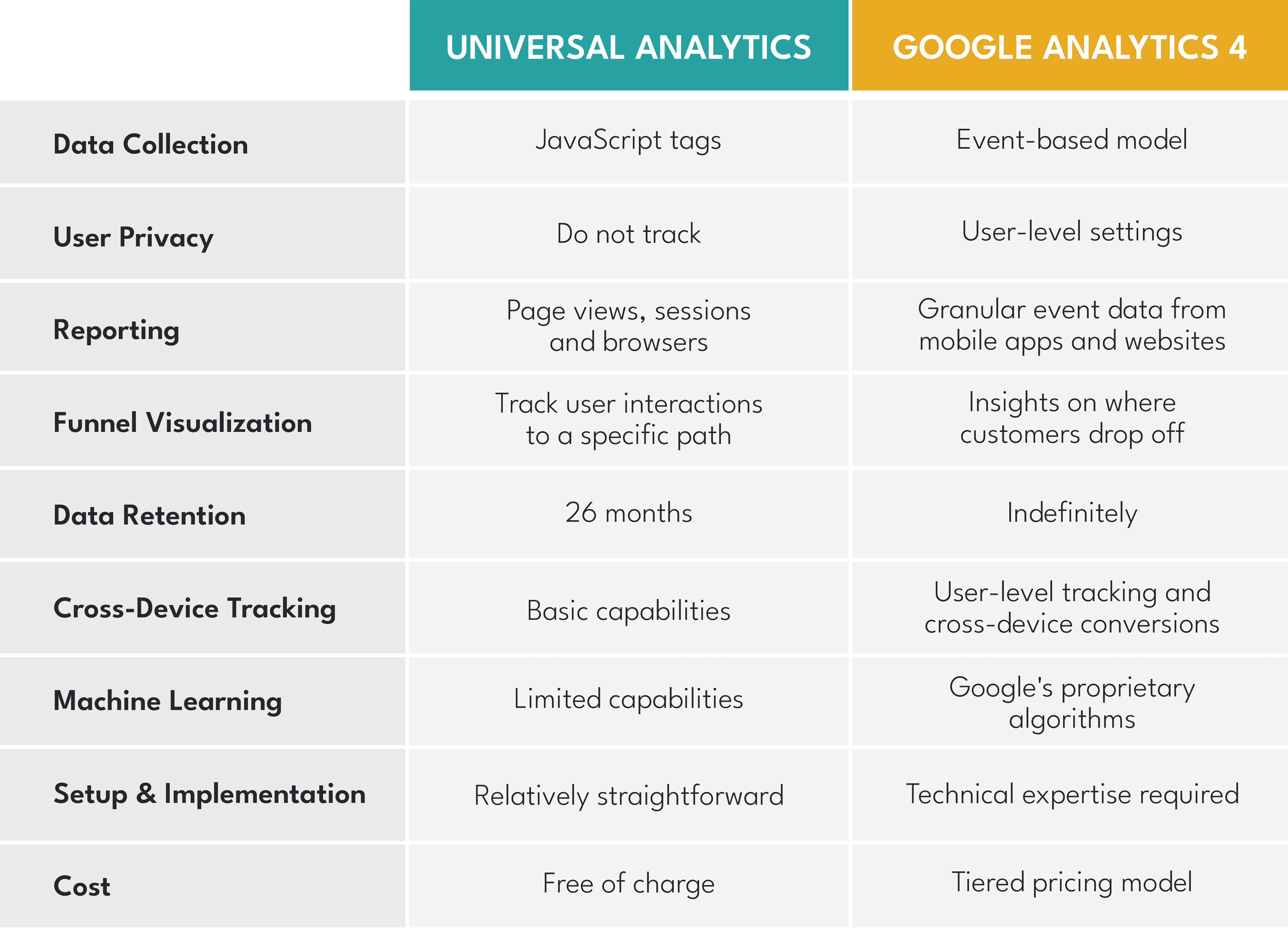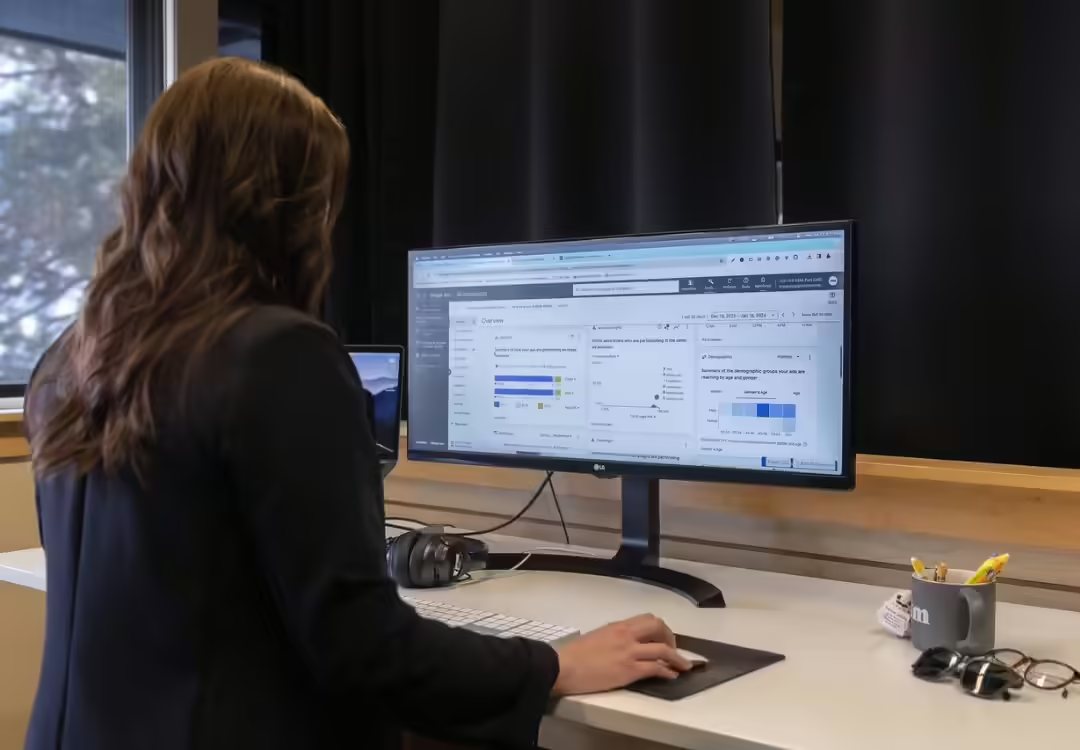What is Google Analytics 4: A Complete Guide to GA4
Google Analytics 4 (GA4) is a powerful tool that helps marketers track customer behavior and make informed decisions based on data-driven insights. Compared to its predecessor, Universal Analytics, it offers more granular goal and event tracking, enhanced reporting capabilities, deeper integration with other tools, improved event parameters, and better audiences for ad campaigns. With GA4’s user-centric metrics powered by AI technology, businesses can anticipate consumer actions quickly to optimize their web presence for maximum conversions and engagement.
Table of Contents

Google Analytics 4 vs. Universal Analytics
Analytics is a core component of any marketing strategy. Without it, we would be operating in the dark – unable to track the success and failure of our campaigns or the impact they are having on our clients’ businesses. Fortunately, thanks to Google Analytics 4 (referred to as GA4 interchangeably moving forward), analyzing data is easier than ever.
The marketing landscape is constantly changing and a marketer’s success relies on their adaptability. That adaptability is as crucial as ever as the Google Analytics 4 migration deadline is upon us. The aptly named GA4 is Google’s 4th generation analytics technology, and come July 1st of 2023, it will be the only available option for analytics tracking.
But do not fear, GA4 offers loads of improvements from our beloved Universal Analytics – truly. To ease your apprehension, we’ve put together an informative guide outlining the improvements you can expect from your GA4 migration.
Before we dig in, let’s revel in some analytics nostalgia.

A Look at Where We’ve Been
We said it at the start – analytics has grown to be our guiding light as marketers.
As one of the most powerful tools at our disposal, analytics enables us to provide increasing value for our clients. By leveraging data-driven technology, we can uncover trends and patterns that would otherwise go unnoticed, identifying opportunities for growth and improvement.
With the ability to track sales performance in real-time and provide accurate depictions of the effects of marketing campaigns, our efforts have increased in both precision and efficiency. The power of analytics freed us to identify trends more quickly, allowing us to provide actionable insights faster and in a more comprehensive manner.
No, analytics is not a new concept, not even kind of new. But, it has exponentially improved over the last few years.

A Look at Where We’re Headed
As the sun sets on Universal Analytics, rest assured that with a dose of adaptability and enduring a period of adjustment, you’ll find the improvements of Google Analytics 4 quite welcomed.
Here’s a quick side-by-side comparison of Google past and present.


7 Improvements of a GA4 Reality
In all that Google has grown to be, its primary intent has always remained to provide value for its users. Naturally, improvements to their software will be made as technology advances and their user’s needs change.
That’s what GA4 is – improved analytics software. Here’s a look at 7 of the biggest improvements of Google’s latest analytics software.
1. Improved Customer Journey Tracking
Universal Analytics tracked data based on sessions focusing on measuring data fragmented by device. In contrast, GA4 puts the user first with event-based tracking.
Instead of focusing on overall sessions, GA4 uses events to track engaged sessions to measure interactions with your business – from page views and clicks to product purchases or video views. With an emphasis on understanding how users interact with your website or app, you can get a better sense of their behavior over time, helping you understand what’s working and where there may be room for improvement.
2. Improved User Engagement Analysis
GA4 offers more insights into user behavior, better data collection options, and more detailed reporting capabilities to help you get the most out of your data.
GA4 no longer uses the Audience, Acquisition, Behavior, and Conversion menus. Instead, it has a “Life cycle” section which breaks up the analysis into Acquisition, Engagement, Monetization, and Retention as well as a “User” section with Demographics and Tech analyses. This allows marketers to gain much deeper insights into how users interact with their website or app leading to a better understanding of customer journeys.

3. Customer-Centric Measurement
GA4 Analytics is taking customer analytics to a whole new level. With its user-centric metrics, GA4 uses AI to understand customer value and behavior in order to guide your decisions with data-driven precision.
Unlike Universal Analytics, GA4’s capabilities go beyond the basics – it can anticipate consumer actions and provide customized insights, ensuring that you have all the information you need to make informed marketing decisions.
Some examples of customer-centric insights include:
- Total users
- New users
- Active users
- Engaged sessions
- Engagement rate
- Engaged sessions per user
- Average engagement time
- Event count
- Conversions
- And more
4. Simplified Events & Conversions
GA4 allows users to take a granular approach to event and conversion tracking. This means you can track your website user behavior at an incredibly deep level – right down to individual clicks, page scrolls, and video plays. More than that, GA4 allows for an unlimited number of distinct events. While there is a limit on the length of each individual event name, this ensures that the data collected can be organized and analyzed easily without becoming too unwieldy.
An event allows you to measure a distinct user interaction on a website or app. For example, loading a page, clicking a link, and completing a purchase are all interactions you can measure with events.
There are a number of automatically collected events (events that GA4 collects by default when you set up the Google tag or the Tag Manager snippet on your website or Google Analytics) that make up the total, the tracked are events that your business can specifically filter in due to their importance. For example, here are some of OTM’s events:
- alltraffic_viewed_three_pagespersession
- organic_viewed_three_pagespersession
- page_view
- user_engagement
- session_start
- first_visit
- scroll
- Schedule A Consult Submit
- click
- requestconsult_formsubmit
Website conversions are events that are flagged as important to your business, and therefore are categorized as conversions. For example, here are OTM’s conversions:
- Schedule A Consult Submit
- requestconsult_formsubmit
- Contact Us Page Submit
- footer_contact_us_formsubmit
This kind of insight can be invaluable in helping you optimize your web presence for maximum engagement. What’s more, it’s all integrated with Google Ads so you can get even better insights into how your campaigns are performing across channels.
5. Enhanced Visualizations and Reorganized Reporting
Easily one of the most impressive improvements with GA4 is Explorations. This tool is a collection of advanced analysis techniques that enable your business to go beyond traditional reports to more accurately predict customer behavior and identify risk factors. This enables businesses to provide better service, optimize resources, and increase efficiency.
With Universal Analytics, reporting capabilities were limited. GA4’s Explorations tool allows users to filter data by dimensions and metrics, create custom reports to analyze user behavior, and track the performance of campaigns. It offers a range of pre-built templates that users can use to get started with their analysis quickly, ultimately creating custom reports to meet your client’s needs.


6. Reworked Event Parameters
GA4 has introduced a major change in how event parameters are used. Gone are the category, action, label, and value parameters available with Universal Analytics. With GA4, you can now create up to 25 custom-named event parameters that offer more flexibility in your event tracking.
7. Deeper Integration and Insights to Influence Better Audiences for Ad Campaigns
GA4’s advanced features give marketers access to more detailed data about their audience than ever before. This allows them to influence their audience creation in Google Ads, with the ability to tailor audiences for specific campaigns and get a higher return on investment from their ad spend. By leveraging this data, advertisers can gain valuable insights into who they should be targeting in order to maximize the success of their campaign.
In addition, GA4’s predictive analytics allows marketers to quickly optimize their campaigns by making real-time changes based on user behavior patterns identified through these powerful metrics. This helps ensure that ads reach relevant users at the right time and increases overall conversions while reducing costs associated with ineffective advertisements or misdirected efforts.

Unlock the Power of Google Analytics 4
Google Analytics 4 is an essential tool for any digital marketer looking to make the most of their data. With its powerful AI-driven insights, simplified goals and events tracking, enhanced visualizations and reporting capabilities, reworked event parameters, and deeper integration with Google Ads campaigns; GA4 provides you with all the information you need to build successful marketing strategies that drive conversions.
By leveraging this data effectively, businesses can ensure they are making maximum use of their resources while providing customers with a high-quality experience. As more marketers embrace these advanced analytics tools, we will no doubt continue to see meaningful improvements in how companies engage with customers online.

Resources and Courses to Get the Most Out of GA4
With so many features in GA4, discerning how best to put it to work for you can be daunting. Fortunately, there are a variety of online resources and courses dedicated specifically to GA4 that can help you better understand the features included with this platform. Here are few we’ve found particularly helpful:
- Coursera’s “Google Data Analytics” Course
- LinkedIn Learning’s “Learning Google Analytics 4” Course
- Skillshop’s “Google Analytics” Course
- Google Analytics Official Website for an in-depth comparison of Universal Analytics & GA4.
About OTM
Founded by Miles and Vallene Kailburn in 2007, OTM is an award-winning creative agency that specializes in creative solutions that combine business strategy and consumer behavior modeling with traditional creative services such as branding, storytelling, digital marketing, and public relations campaigns to help businesses grow demand and expand into new markets.
With headquarters in Fort Collins, Colorado, the OTM team hails from around the entire United States and works with businesses that span the globe.
Insights
Account-Based Marketing Tactics for B2B Services Firms: Grow Your Pipeline
Account-Based Marketing (ABM) is a strategic approach to B2B marketing that concentrates sales and...
B2B Lead Generation: Proven Strategies for Success
B2B lead generation is essential for growing any business in the technology sector. It involves...
LinkedIn Ads for B2B: Maximizing Lead Generation and Sales
LinkedIn has become a powerful tool for B2B marketers looking to target professionals and...
The B2B Marketing Funnel: Calculating Your Way to More Sales
Tired of marketing efforts that feel like a shot in the dark? A common pain point we see with our...




